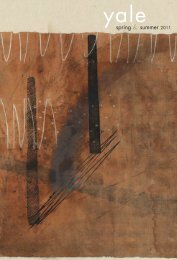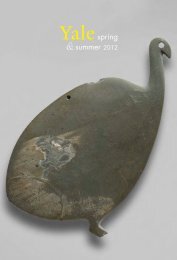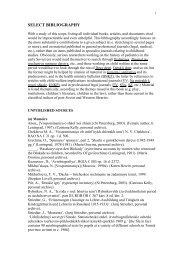View & Download - Yale University Press
View & Download - Yale University Press
View & Download - Yale University Press
Create successful ePaper yourself
Turn your PDF publications into a flip-book with our unique Google optimized e-Paper software.
The Origins of Classical Architecture<br />
Temples, Orders and Gifts to the Gods in Ancient Greece<br />
Mark Wilson Jones<br />
Art 45<br />
Greek temples captivate anyone with an interest in antiquity, and the<br />
Doric, Ionic, and Corinthian columnar orders that clad them launched<br />
the classical architectural tradition down to modern times. The Origins<br />
of Classical Architecture proposes groundbreaking new theories in both<br />
areas as it elucidates the nature and function of Greek architecture.<br />
While contextualising past debate and prevailing, frequently<br />
evolutionary assumptions, Mark Wilson Jones explains how the orders<br />
emerged over a relatively short period in response to cultural<br />
developments, human agency and artistic inspiration. Temples were<br />
houses for the gods while also considered as offerings to them, and thus<br />
made appropriately from enduring materials and grandly scaled. These<br />
structures, furthermore, sheltered votive offerings of great artistic<br />
quality, the design of which influenced that of the temples and the<br />
creation of the new architectural forms. Temples and their orders<br />
thereby symbolised the dedication of effort and artistry to the cause of<br />
religious expression and collective identity.<br />
December<br />
288 pp. 285x220mm.<br />
30 colour + 230 b/w illus.<br />
HB ISBN 978-0-300-18276-7 £40.00*<br />
Mark Wilson Jones is an architect and architectural historian. He is<br />
director of postgraduate research, department of architecture and civil<br />
engineering, at the <strong>University</strong> of Bath.<br />
The Sheldonian Theatre<br />
Architecture and Learning in Seventeenth-Century Oxford<br />
Anthony Geraghty<br />
A jewel of the <strong>University</strong> of Oxford, the Sheldonian Theatre stands out<br />
among the groundbreaking designs by the great British architect Sir<br />
Christopher Wren. Published to coincide with the 350th anniversary of<br />
the building’s construction, this meticulously researched book takes a<br />
fresh look at the historical influences that shaped the Sheldonian’s<br />
development, including the Restoration of the English monarchy and<br />
the university’s commitment to episcopal religion.<br />
The book explains just how novel Wren’s design was in its day, in part<br />
because the academic theatre was a building type without precedent in<br />
England, and in part because the Sheldonian’s classical style stood apart<br />
in its university context. The author also points to a shift in the<br />
guiding motivation behind the architecture at Oxford: from a tradition<br />
that largely perpetuated medieval forms to one that conceived classical<br />
architecture in relation to late Renaissance learning. Newly<br />
commissioned photographs showcase the theatre’s recently restored<br />
interior.<br />
Anthony Geraghty is senior lecturer in the history of art at the<br />
<strong>University</strong> of York.<br />
September<br />
168 pp. 256x192mm.<br />
40 colour + 10 b/w illus.<br />
HB ISBN 978-0-300-19504-0 £35.00*<br />
Published for the Paul Mellon Centre for Studies in British Art












